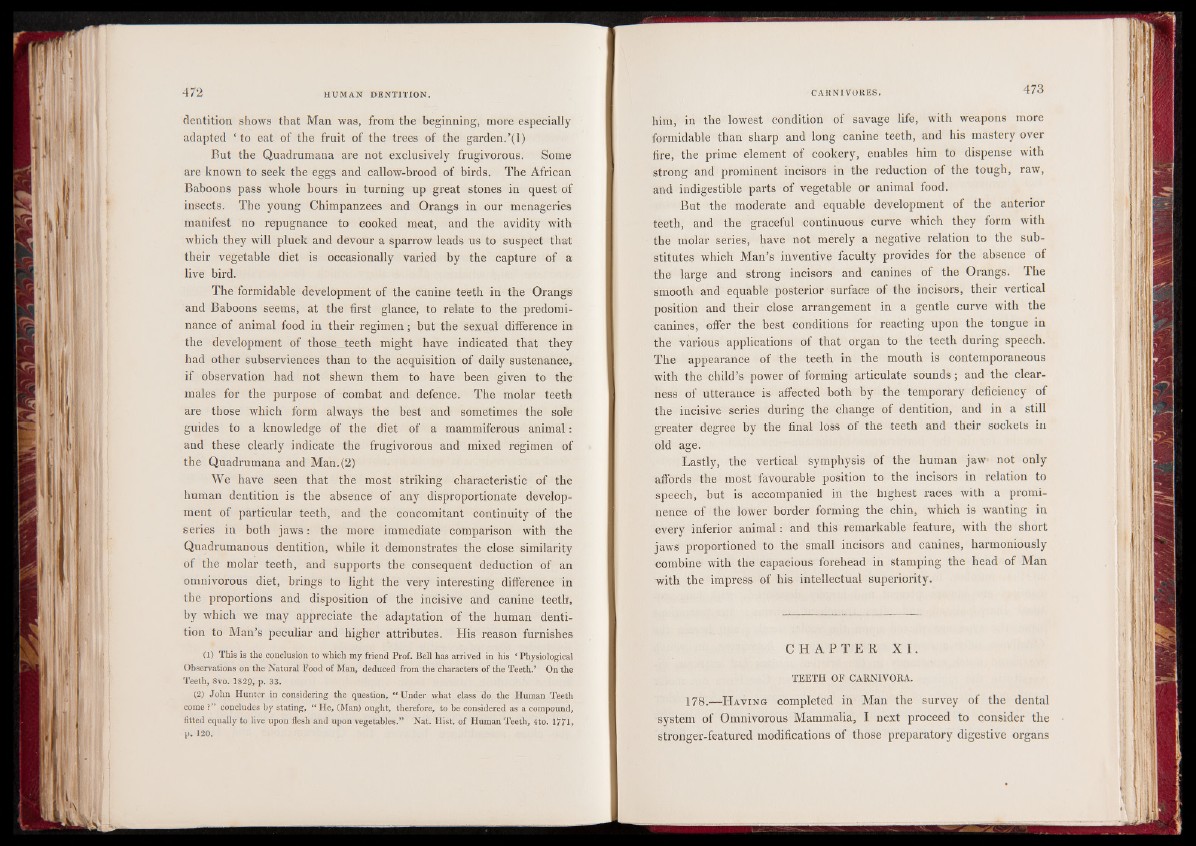
dentition shows that Man was, from the beginning, more especially
adapted ■ to eat of the fruit of the trees of the garden.’'(I)
But the Quadrumana are not exclusively frugivorous. Some
are known to seek the eggs and callow-brood of birds. The African
Baboons pass whole hours in turning up great stones in quest of
insects. The young Chimpanzees and Orangs in our menageries
manifest no repugnance to cooked meat, and the avidity with
which they will pluck and devour a sparrow leads us to suspect that
their vegetable diet is occasionally varied by the capture of a
live bird.
The formidable development of the canine teeth in the Orangs
and Baboons seems, at the first glance, to relate to the predominance
of animal food in their regimen; but the sexual difference in
the development of those teeth might have indicated that they
had other subserviences than to the acquisition of daily sustenance,
if observation had not shewn them to have been given to the
males for the purpose of combat and defence. The molar teeth
are those which form always the best and sometimes the sole
guides to a knowledge of the diet of a mammiferous animal:
and these clearly indicate the frugivorous and mixed regimen of
the Quadrumana and Man. (2)
We have seen that the most striking characteristic of the
human dentition is the absence of any disproportionate development
of particular teeth, and the concomitant continuity of the
series in both jaws: the more immediate comparison with the
Quadrumanous dentition, while it demonstrates the close similarity
of the molar teeth, and supports the consequent deduction of an
omnivorous diet, brings to light the very interesting difference in
the proportions and disposition of the incisive and canine teeth,
by which we may appreciate the adaptation of the human dentition
to Man’s peculiar and higher attributes. His reason furnishes
Cl) This is the conclusion to which my friend Prof. Bell has arrived in his ‘ Physiological
Observations on the Natural Food of Man, deduced from the characters of the Teeth.’ On the
Teeth, 8vo. 1829, p. 33.
(2) John Hunter in considering the question, "Under what class do the Human Teeth
come ?** concludes by stating, "He, (Man) ought, therefore, to be considered as a compound,
fitted equally to live upon flesh and upon vegetables.” Nat. Hist, of Human Teeth, 4to. 1771,
p. 120.
him, in the lowest condition of savage life, with weapons more
formidable than sharp and long canine teeth, and his mastery over
fire, the prime element of cookery, enables him to dispense with
strong and prominent incisors in the reduction of the tough, raw,
and indigestible parts of vegetable or animal food.
But the moderate and equable development of the anterior
teeth, and the graceful continuous curve which they form with
the molar series, have not merely a negative relation to the substitutes
which Man’s inventive faculty provides for the absence of
the large and strong incisors and canines of the Orangs. The
smooth and equable posterior surface of the incisors, their vertical
position and their close arrangement in a gentle curve with the
canines, offer the best conditions for reacting upon the tongue in
the various applications of that organ to thé teeth during speech.
The appearance of the teeth in the mouth is contemporaneous
with the child’s power of forming articulate sounds; and the clearness
of utterance is affected both by the temporary deficiency of
the incisive series during the change of dentition, and in a still
greater degree by the final loss of the teeth and their sockets in
old age.
Lastly, the vertical symphysis of the human jaw' not only
affords the most favourable position to the incisors in relation to
speech, but is accompanied in the highest races with a prominence
of the lower border forming the chin, which is wanting in
every inferior animal: and this remarkable feature, with the short
jaws proportioned to the small incisors and canines, harmoniously
combine with the capacious forehead in stamping the head of Man
with the impress of his intellectual superiority.
C H A P T E R X I .
TEETH OF CARNIVORA.
178.—H a v in g completed in Man the survey of the dental
system of Omnivorous Mammalia, I next proceed to consider the
stronger-featured modifications of those preparatory digestive organs